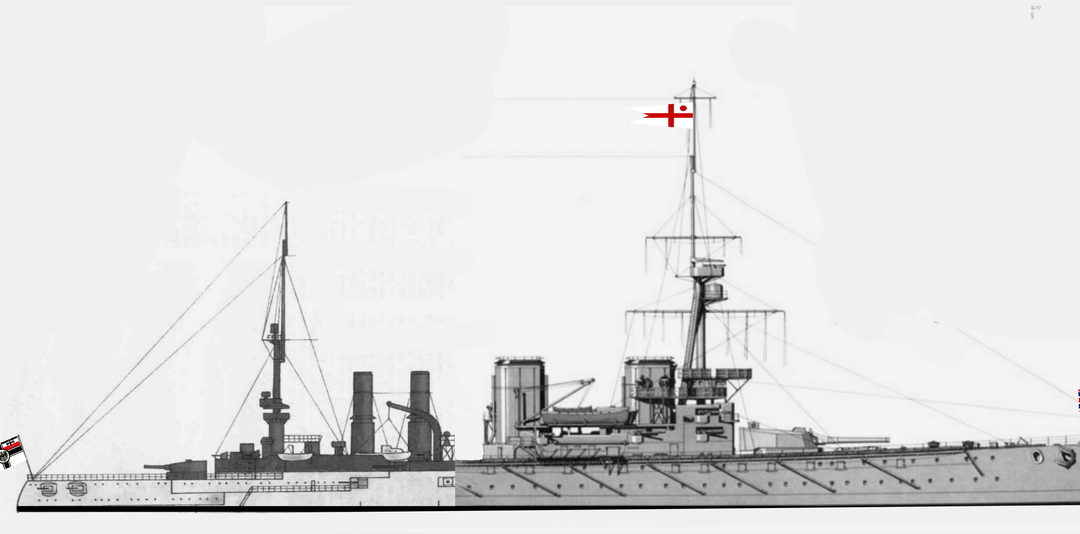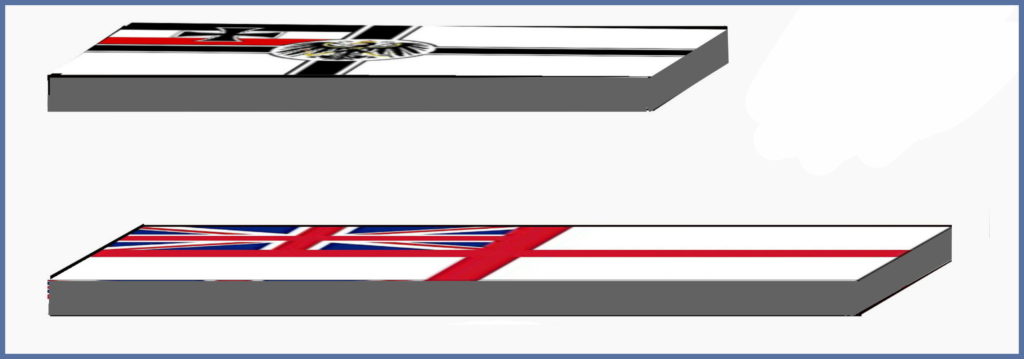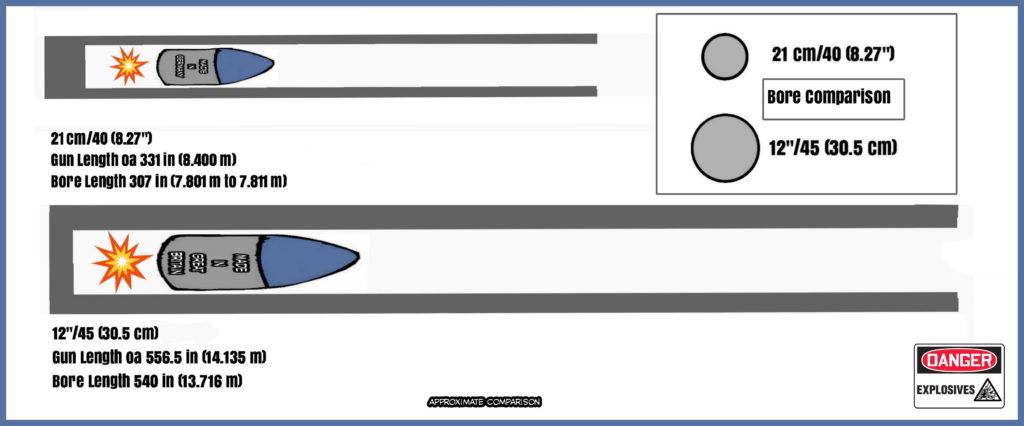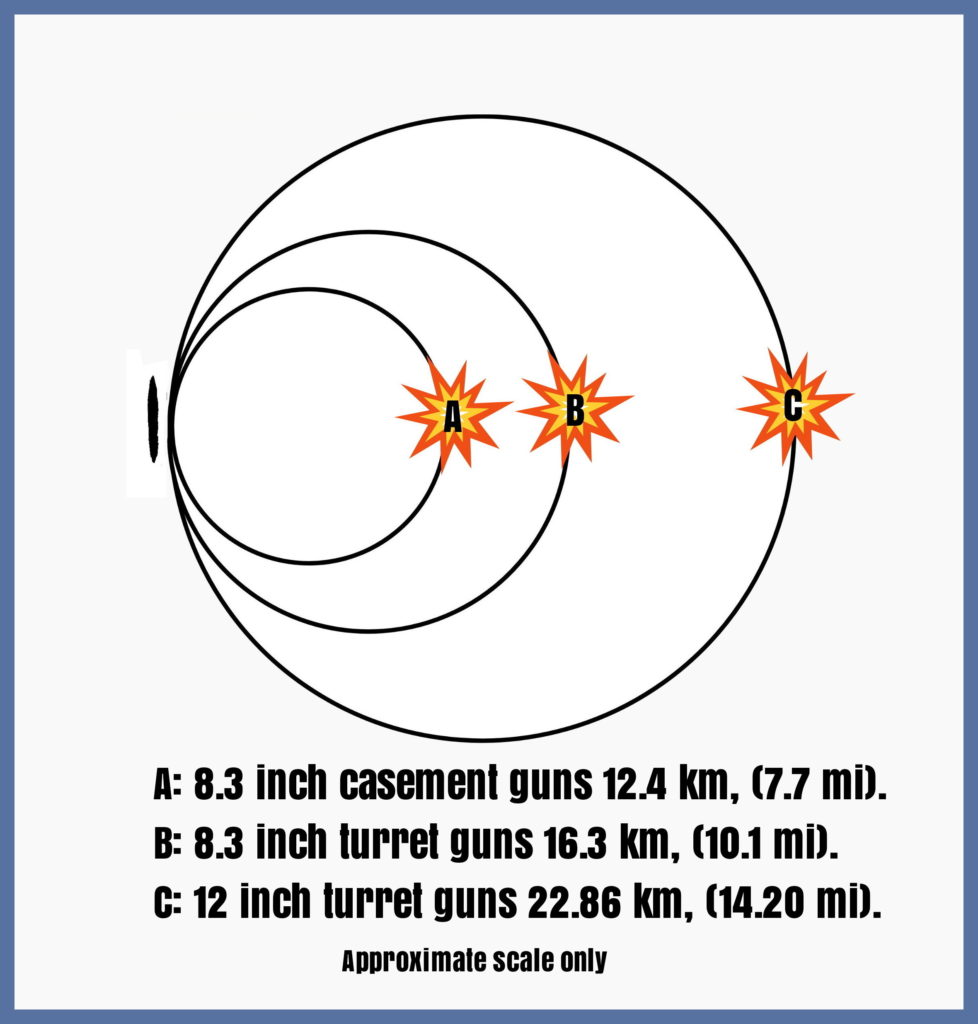On the first day of November 1914, the Royal Navy was to suffer its first
defeat in over a century, denting both its pride and the hard fought for,
Nelsonic image. But thirty-Seven days later, retribution in the form of
seven Royal Navy cruisers was to be delivered in an effort to rectify the
humiliation.
On a cold Tuesday, 8th December 1914, in the South Atlantic, deep
within the hulls of the two British Battlecruisers, HMS Invincible and
Inflexible, stokers worked in blast furnace like temperatures striving to
wring every extra knot possible from the two ships powerplants. Many
decks above in the four turrets, that housed the eight mammoth guns,
the weapons crews waited, frustrated, with their charges loaded,
waiting for the range to diminish and the order to commence fire to be
given. Looming high over the foremost turret, the bridge crews strained
through their binoculars to watch the largest of the smoke topped
smudges that lined the distant horizon. Since 10:00 that morning, the
British squadron had given chase from a standing start, their quarry
being the hastily retreating German East Asiatic Squadron.
Equally deep within those Germanic hulls, more stokers sweated in turn
before their own fires, to gain every extra knot, and then to demand
more. As hard as the British strove to close the distance, the German
commander, Vice-Admiral Maximilian Johannes Maria Hubert
Reichsgraf von Spee, sought to lead his ships to escape. His prayer was
for poor weather to shroud them from the intrusive British eyes, or to
survive the chase until the sun set, and the cloak of darkness could
finally shroud them from their tireless predators.
All that morning the British Commander-in-Chief, of the South Atlantic
and South Pacific Squadron (Vice-Admiral Frederick Charles Doveton
Sturdee) had watched as his seven ships, (HMS Invincible, Inflexible,
Kent, Carnarvon, Cornwall, Glasgow and Bristol), strove to draw the
intervening gap closed. But though the pursuit went far too slowly, the
British drew remorselessly ever closer to the Germans. Distant on the
horizon five smudges of funnel smoke marked the hard steaming SMS
Scharnhorst, Gneisenau, Dresden, Leipzig and Nuremberg. But as the
minutes ticked by, the small dots under their individual plumbs of
smoke drew gradually larger before British eyes, and not smaller as the
German crews had prayed for. Each turn of the ships propellers brought
the day’s inevitable conclusion closer and it slowly became more
unavoidable for the German Admiral.
Hours earlier, while the British ships lay in port coaling, two German
cruisers had peered into the anchorage from out at sea. The intrusion
brought at 08:30 the Royal Navy crews summons to action stations. But
it was only after nearly three hours of steaming, at 12:55, that the
range was deemed on the flagship, HMS Invincible, to have been finally
reduced sufficiently for the guns to commence their afternoons work.
Orders were passed from Admiral, to Captain, from Captain to Gunnery
Officer, and then on down the chain to the waiting turret crews.
With the long-awaited order received, the elevation and direction the
turret crews had waited for was set. Slowly the turrets rotated, and the
barrels were lifted towards the distant goals. All was ready and now fire
was given, hurling those first shells out towards 14,000 yards. The shells
screamed down to create fleeting water sculptures near the German
armoured cruiser, Scharnhorst. The Invincible’s log soon claims two hits
to have be made. The Inflexible minutes later was to join the battle and hurl her own first salvoes across the watery void, towards the
Gneisenau.
Neither German ship gave answer to the challenge, ammunition was
too scarce to squander and the range was long, even for their 8.27-inch
guns. With one sea battle already fought (and won), the shortage of
ammunition was too much of a handicap to warrant the futility. But
finally, at 13:35, von Spee excepted escape for him was not to be
possible and the inevitable was upon him. Having released his three
light cruisers to try and seek an escape, he turned the Scharnhorst and
the Gneisenau to port to sacrifice themselves to permit the smaller
cruisers their opportunity to seek freedom. Only then did he permit the
half empty magazines to feed the waiting guns and fire to be returned
at the two Battlecruisers that had been snapping like terriers, at his
heels all that morning.
Both Vice-Admirals knew what outcome the day’s end would bring,
unless Germanic-luck was to intervene. By the day’s end, the
Scharnhorst and the Gneisenau would both be pounded to wrecks and
at rest upon the sea bed. It could only be inevitable, as a battlecruiser
so easily out classed the obsolete armoured cruiser. The unfolding
battle was the very reason for the battlecruiser concept. Was there
even a chance or a glimmer of hope for those German seamen so far
from home? Or was the disparity between the two warship types just
too much for the Germans to overcome? We already know the answer
to that pointless question, but indulge me, and let us see how big the
gap was that day, and if von Spee was doomed with no chance of
escape, or if his crews stood any chance of seeing a fresh South Atlantic
day.
First, let us begin with the size and weight of the days four main
combatants. The two German Armoured Cruisers were 474 feet 5
inches in length, which translates to 144.6 meters. To make an easier
visual comparison, if we were to take a modern four door family car,
which on average is listed as 15 feet (4.20. mtrs) in its length,
Gneisenau’s hull was thirty-one of those cars at her waterline, with a
smaller one door car tagged on at the end to complete the comparison.
Using the same automotive measurement, the Battlecruisers were at
their waterline, thirty-five (& a half) cars in length, or in dimensions,
530 feet 1 inch (161.57 meters). Thus, the difference between
armoured and battle cruiser was 55 feet 6 inches (16.97), or four cars
(11-12% longer).
In the matter of beam (or width), the Gneisenau was 70 feet 10 inches
(21.6 mtrs) and the Invincible 78 feet 10.13 inches (24.03 mtrs), the
difference being 8 feet, (2.43 mtrs). In the amount of draught, the four
hulls carried, the Armoured Cruisers were 27 feet 6 inches (8.277 mtrs)
and the Battlecruisers 29 ft 9 inches (9.07 mtrs) at deep load, so a
difference of 2 feet 3 inches, which for the weight of main caliber guns
carried, is a surprisingly small amount.
In weight or displacement, the Gneisenau was 11,433 long (Imperial or
British) tons while ‘unladen’ and the Invincible 17,290 long tons whilst
in a similar state, (51.22% difference). Once the coal, oil, munitions,
water, food and the thousands of items a warship needs to be ready for
sea were brought onboard, the totals increased respectively to 12,780
and 20,700 long tons, (61.97% difference). The 7,920 tons was
substantially more than von Spee’s detached light cruiser, SMS Emden,
which weighed normally 3,606 long tons and when fully loaded, 4,201
long tons.
Probably the heaviest weight contributing towards those displacements
were the turrets. The British ships each held four of the massive steel
fortifications, individually housing a pair of 12-inch guns. One turret
was situated facing forward over the bow, another facing aft. The
remaining two turrets were diagonally amidships. The weight of each
one of these four metallic fortresses was between 450 & 500 tons, (that
is about 383 of those family cars, per turret). In comparison the two
turrets mounted on each of the Armoured Cruisers were 88.6 tons as
single units (67-68 cars). If you were then to add the weights of the
individual barrels or guns to the turret weights, (Britain, 74 tons/56-57
cars & Germany, 19.70 tons/15-16 cars per barrel), approximate total
of 648 tons/497 cars and 128 tons/ 87-88 cars per turret is reached.
The British turrets were of such a huge size in comparison, that one 12-
inch barrel alone equated to 83.52% of one (all be it without gun
barrels) Germanic turret and the total individual weights differed by
520 tons/399 cars.
We will keep the question of the level of power supplied from each
engine room simple. The Scharnhorst’s three propellers gave
revolutions for 22.5 knots, and the Invincible’s four in turn provided
26.48 knots. The 3.98 knot difference is a good walking speed, given the
average person strides out at 4.58 mph. But it also needs to be factored
in that all four ships had just completed long voyages to the Falklands,
(12,000+ miles for the Germans & 7,000+ miles for the British), and
with the marine growth accumulated on the hulls during these voyages differing in the quantity, their maximum speeds would have been
affected to varying amounts.
Finally, before we move on, for every hour Sturdee’s ships had given
chase, the distance between the four ships diminished by 4.58 miles
(7.37 km), a figure worth bearing in mind when we come to the reach
of the main caliber and how soon the British guns could realistically
expect to be within range of their goals.
The next subject that needs to be examined is the reason for the ships
existence, the main caliber guns. Everything was secondary to these
weapons and was there merely to serve and support them in one-way
or another. The engines existed to ensure the guns could be delivered
safely to where they were required. The crews (Invincible up to 1,000 in
wartime, Gneisenau 764) were on-board to either directly serve the
guns or to support them in a subordinate mode. The secondary guns
purpose was to fend off threats to the hull, and thus preserve the all-
important big guns.
The Gneisenau’s main gun caliber was comprised of eight 8.27-inch (21
cm) guns, four of which, (as we have noted), were mounted within two
turrets. Equally, the Invincible had eight 12-inch (30.5 cm) guns,
mounted into four turrets. The superiority of the British guns is obvious
with a difference of 3.7 inches (9.39 cm), but as obvious as the size
disparity was, how much authority had those 3.7 inches given to the
British crews?
Each of the German four 8.27-inch turreted guns (C/01 version) were
27 feet, 7 inches (8.407 mtrs)1.83 cars)) in length, with a bore measurement of 25 feet 7 inches (7.797 mtrs). The weapons
individually weighed 44,137 lbs. (20,020 kg), or 20.02 tons. That is
around 15-16 of those family cars, per weight of per barrel. These
Krupp designed and manufactured weapons were the Armoured
Cruisers primary armament, being mounted on the center line in two
twin gun turrets, one fore and one aft of the main superstructure. The
four remaining 8.27-inch guns (C/04 version) were mounted within
single casemates amidships, two facing out to port and two to
starboard. The C/04 was marginally lighter than the C/O1, at 41,667
lbs., (18,900 kg) and whereas the turreted C/O1 was hydraulically
powered, the casement CO/4 was electrically trained and manually
elevated. By their very placement within the hull, the casemented guns
were restricted in their maximum elevation to 16 degrees a total of 14
points less than their turreted siblings. The gun placements allowed the
two Armoured Cruisers a broadside of six guns on both beams, but
bizarrely, over two maximum ranges.
The British 12-inch gun (mark ‘X’ version) was 46 feet 4.5 inches (14.135
mtrs) 3-4 cars)) in length, with a bore of 45 feet (13.716 mtrs). The
individual weapon, (with breech) weighed 129,348 lbs. (58,626 kg) or
57.74 tons. Using the family car comparison once more, the single gun
weight equates to 44-45 of our four-door car. The German 8.27 inch
were 18 feet 9 inches (or 59.53%) shorter than their British adversaries
in their overall length.
The British ships had in theory a broadside of four turrets and eight
guns. The two centrally mounted turrets were staggered in their
placement, giving them the capacity to fire on either beam by shooting
across the width of the mid-ship deck. But at “ the Falklands battle,
Invincible fired cross-deck with both P and Q turret but this dazed
and deafened the gun-layers, trainers and sight setters as well as
causing blast damage to the deck. P turret reported that the
trainers had to be replaced constantly during the battle as they
were too dazed to function properly. After the battle, cross-deck
firing was ruled out except in cases of emergency.” [
http://www.navweaps.com/] As a result, the eight-gun broadside was after the battle restricted to
six, (unless it was a matter of life or death), but for this one
engagement the Battlecruisers fielded all eight of their main weapons.
But having delivered their 8.27 or 12-inch shells on target, how much
damage did they inflict on their detonation? The Gneisenau’s armour
piercings shells weighed 237.4 lbs. (107.7 kg) and the casement guns,
when fired at a 16-degree elevation, could dispatch one of those
projectiles a distance of 7.7 miles (12.4 km). But the four turreted 8.27-
inch guns, (with their greater elevation of 30°), could deliver their shells
a further 2.4 miles, reaching out to 10.10 miles (16.3 km). A good and
well-trained gun crew, (both ships had prior to the war, won the
prestigious Kaiser’s Schießpreis (Kaisers Shooting Prize), (Scharnhorst in
1909/10 & Gneisenau 1908/1909 & 1910/11)) would be able to achieve
between 4 and 5 salvos per minute. Depending on the elevation
available, in those sixty seconds, 20 to 30 shells would cross the void
that lay between the battling adversaries, travelling at 1,744.81 mph
(2,808 kph). The total weight of shell fired within a two-minute period
was 6.35 tons at 7.7 miles or 4.23 tons at 10.10 miles.
The British APC shells in turn weighed 850 lbs., a staggering 613 lb.
(258%) increase over the German projectile. The heavier shell could be propelled out to a maximum of 14.20 miles (22.86 km), travelling at a
faster 1857.95 mph, out ranging their German opponents by 4.20 miles.
Over a two-minute period the Germans fired up to 10 broadsides, and
the British 3 salvoes. Even with the slower rate of fire (1.5 per minute)
achievable by the British, their heavier shell dominated the German
response at 9.10 tons per 2 minutes, a 2.75-ton dominance at 7.7 miles,
and 4.87 tons at 10.10 miles.
The 4.20 miles by which the Germans were out ranged by the British
12-inch, would have required the Armoured Cruisers at their top speed
of 22 knots, a tortuously long 11 minutes 20 seconds to cross. Only
once having somehow steamed faster than the British, plus having also
survived the 17 uncontested salvos those 11 minutes plus would allow
and finally successfully crossed that British shooting range, could the
Germans give reply with their two ships four turrets. Those 11 minutes
plus would have most likely felt to the German crews as the longest 680
seconds in their life’s.
As the German and British shells plummeted down around their
respective targets, the German exploded with a force of 7.67 lbs. (3.5
kg) [AP L2,9], and the 12-inch British shell [APC Mark VI] with 26.3 lbs.
(11.9 kg). As a result of the slower rate of fire, the British shells had an
18.63 lb. larger explosive force. The Invincible’s eight-gun broadside
could in theory deliver 631.2 Ibs. of explosive force per two minutes
within the target area. However, using just, the four quicker firing 8.27-
inch turreted guns, the Germans could deliver 306.8 Ibs. per two
minutes. But if von Spee could lure the Battlecruisers to within range of
both the turret and casement guns, he could deliver his heaviest
broadside at 460.2 Ibs. weight of explosive force over those 120
seconds. However, getting the shells onto their target is nothing, if the
detonation lacks the force to penetrate the enemies armour on impact.
In the 1904 edition of Janes Fighting Ships the German shell is noted as
having the power to penetrate 6.5 inches of armour at 5,000 yards, and
9 inches at 3,000 yards. In response, at 10,000 yards (9,144 mtrs) the
British shell could pierce 10.6″ (269 mm), and at 7,600 yards (6,950
mtrs), 12-inches (305 mm) of armour. Given those figures, the
Armoured Cruisers had no armour that could withstand an impact by
the 12-inch shells being hurled at them. In turn the German shells were
capable of penetrating the Battlecruisers belt at between 4,000 and
5,000 yards. The deck armour was vulnerable at less than 6000 yards,
but the turret would require the range to be closed to less than 5,000
yards. The 10-inches of the conning tower would necessitate a suicidal
range less than the 3,000 yards.
The only other major factor to consider was the content of the
magazines. The German squadron had already fought one battle off
Chile’s coastline the month before and had also conducted several
bombardments as they had steamed their way east across the Pacific.
We do not know the quantity of the limited shell supply that remained
to the German gun crews, how many were Armour piercing and how
many were High Explosive? Only the former were of any significance on
the day, but for how long could the guns be supplied with them? It is
likely given the two Armoured Cruisers faced at Coronel, a significant
proportion had been expended to ensure their rapid demise.
By the time, the first salvoes were fired on that December day, the
sources report that the Scharnhorst and Gneisenau’s magazines were
only 40% full, which (given each gun had a supply of 85 shells), equates
to 35 per gun, which is less than ten minutes of rapid firing. By the time,
the Gneisenau had come to near the end of her struggle, the survivor’s
reported her magazines to have been empty and the gunners resorting
to using non-explosive training rounds. Even with those, Gneisenau was
still able to land shells onto her tormentors. We can assume that the
Scharnhorst was lost before her magazines were empty, as her guns
were still active as she finally succumbed to the damage wrought on
her. But given the 100% mortality rate on that dying ship, we will never
know if those final shells were training or live. But both the Armoured
Cruisers lived up to their prize-winning shooting reputation and were to
deprive the British of the simple and easy victory their dominance
would imply.
One final factor was the quality of the crews that served the guns and
sailed the warships on that day. A large percentage of the British crews
were drawn from the Royal Naval Reserve and had only in the last few
months been recalled to the colours. A new crew takes time to settle in
and to reach peak efficency. The German crews were the polar
opposite, having in the majority served together both in time of peace
and war. The crew members served two years each on the China
station, 50% being rotated home every year. The German sailors were
on that December day, amoungst the finest and well-trained serving on
any warship at that period.
TO CONCLUDE.
From the other side of the battle, British gunnery was poor, at one
point in the exchange achieving 4 hits out of the 210 shells fired (1.9%).
It was to be claimed post battle that the smoke from the guns and
funnels, since the Battlecruisers were upwind of the Germans, had
been the cause. But British gunnery right up until late 1916 was
generally less accurate with the opening shots than their Germanic
cousins. In turn the Invincible had fired 513 shells from her main guns
during the battle but achieved only twenty-two hits (4.28%).
Inflexible fired 661 twelve-inch shells during the battle but was hit in
return three times due to her obstruction by the Invincible’s smoke. The
Invincible was to suffer two of her bow compartments flooded, and one
hit on her waterline below ‘P’ turret which had caused a flooded coal
bunker. This inflicted her with a temporarily 15° list.
At the start of this article, we already knew von Spee and his two
sacrificial Armoured Cruisers were doomed. As they turned to face their
assailants, they were facing up to odds that were insurmountable. But
now we know how large that doom was. It has been confirmed that the
Battlecruisers were dominant in both their displacement and
dimensions. Everything about the two British ships was bigger,
something the main caliber guns and their shells demonstrated. But
three factors were the signposts that pointed to that doom.
1: No matter how hard the German stokers worked at their furnaces,
the British superior speed was always going to close the gap. Only poor
weather and the arrival of nights cloak of darkness would allow the
Germans to break free, but there was insufficient time remaining on
the days clock for those to play a role on that day.
2: The German gunners could send far more shells towards their British
opponents with every salvo. But they were working from heavily
depleted magazines and faced in turn British magazines that were
stocked to capacity. The British could fire until the German magazines
were emptied and had nothing but empty racks, and then carry on as
the 8.27-inch guns fell permanently silent.
The smaller number of British shells that landed around and
occasionally on the German ships were larger and carried a greater
destructive force. But the gunners on the Armoured Cruisers were
hampered in an already one-sided exchange by the range limitations of
the casement guns. Von Spee needed to close the range to maximize
his broadside weight, but he lacked the superior speed to achieve that.
No matter what he did, and how superior his gunners aim was, the
German volume of shell was out matched by the bigger British bang.
3: The German 8.27-inch shells were obviously significantly lighter than
the British shells, and until the range was diminished, which without
the speed advantage was not going to happen, the British armour
would defy the efforts of the German armour piercing shells to
penetrate the Battlecruisers vitals.
But such a problem did not face the British gunners, and the few shells
they hit home with, would pierce the defending armor, and enter the
ships interiors, where their bigger detonation would cause more
damage. The Germans could pepper the opponents all afternoon with
continuous hits, but if they somehow entered the British ships vitals,
their detonation and destructive force was considerably less than the
British shells. Nonetheless the 12-inch shells, even if they hit home far
more infrequently, caused catastrophic and fatal damage.
From that last turn to port, von Spee was sacrificing his two biggest
ships, but the only influence he had was on the price the British paid
and the damage it caused to the Battlecruisers exteriors. It was typical
of a great Admiral and was both brave and fatal, it was just a question
of how long it took to prove to be so.
Want to read more great articles by Andy South? Check out some of his other articles!












Recent Comments